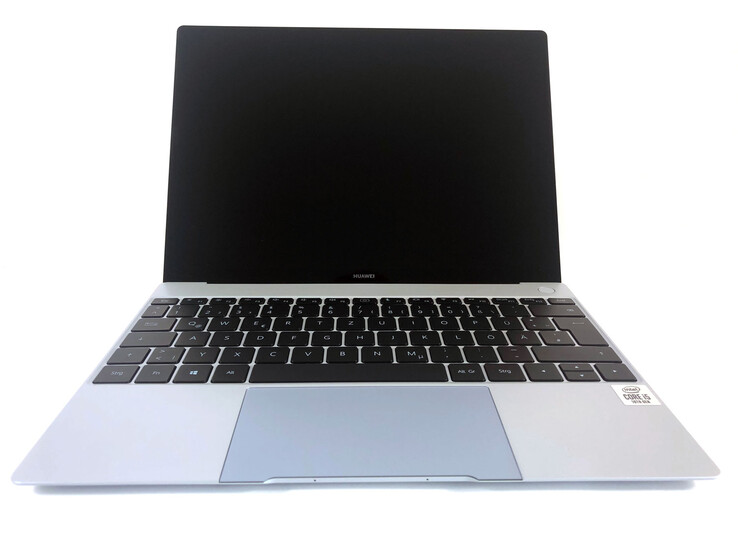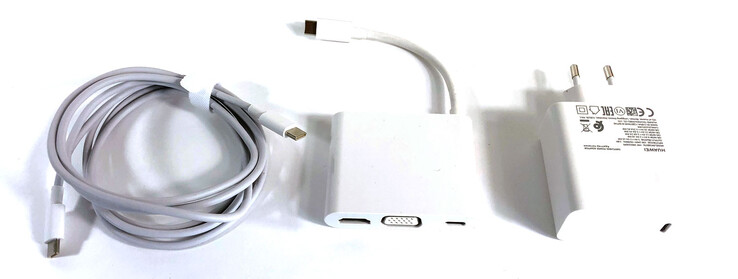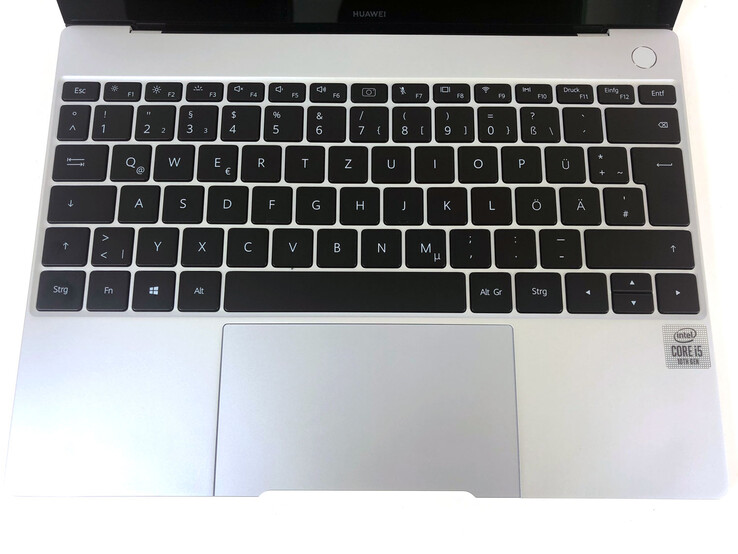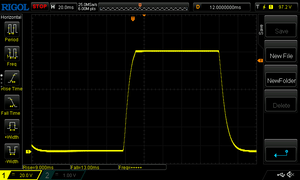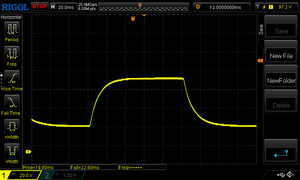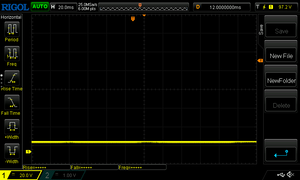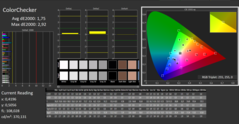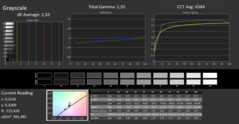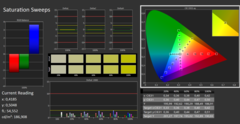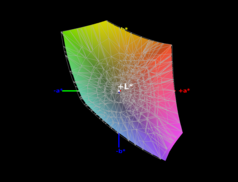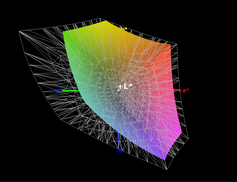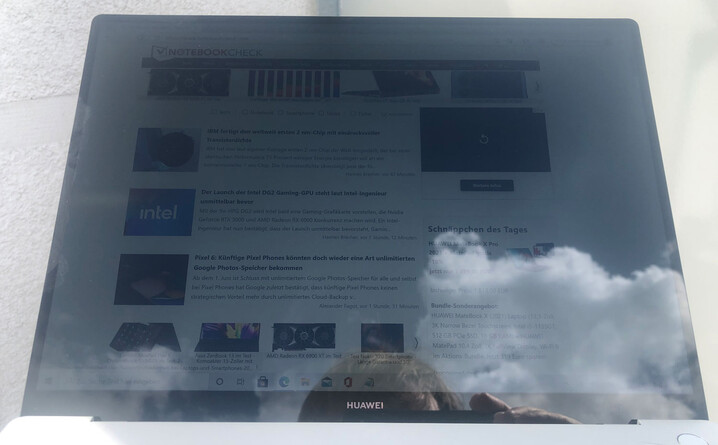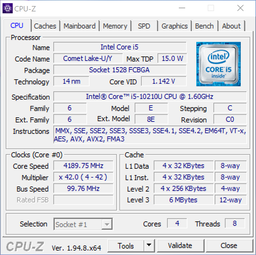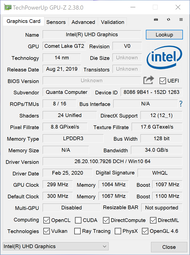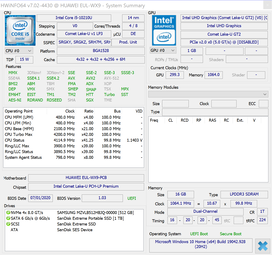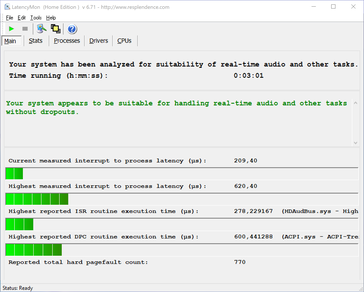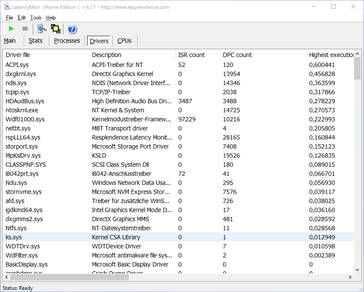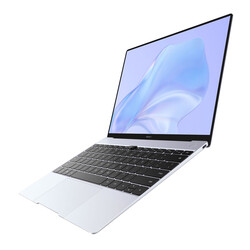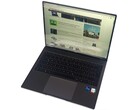Huawei MateBook X in review: Ultra-thin, extremely light and absolutely silent

The competition around lightweight 1 kg (~2.2 lb) notebooks is relatively few. This is especially true when it is also a passively cooled device. This is implemented with a restrained Intel Core i5-10210U including onboard graphics, which Huawei combines with 16 GB LPDDR3 RAM and a great 3K display.
In our test, the Huawei MateBook X Silver Frost (2020) has to show what it has to offer and compete with other, sometimes significantly more powerful subnotebooks. Among other things, we will examine how the MateBook X compares to the also very light LG Gram 14Z90N and the more powerfully equipped MateBook X Pro.
Possible competitors in comparison
Rating | Date | Model | Weight | Height | Size | Resolution | Price |
|---|---|---|---|---|---|---|---|
| 87.6 % v7 (old) | 05 / 2021 | Huawei MateBook X Silver Frost (2020) i5-10210U, UHD Graphics 620 | 1 kg | 13.6 mm | 13.00" | 3000x2000 | |
| 87.8 % v7 (old) | 03 / 2021 | Huawei MateBook X Pro 2021 i7-1165G7, Iris Xe G7 96EUs | 1.3 kg | 14.6 mm | 13.90" | 3000x2000 | |
| 84.4 % v7 (old) | 06 / 2020 | Huawei MateBook 13 2020 i5 i5-10210U, UHD Graphics 620 | 1.3 kg | 14.9 mm | 13.00" | 2160x1440 | |
| 87.6 % v7 (old) | 03 / 2021 | Lenovo Yoga Slim 7i Carbon 13 ITL i7-1165G7, Iris Xe G7 96EUs | 975 g | 15 mm | 13.30" | 2560x1600 | |
| 85.3 % v7 (old) | 05 / 2020 | LG Gram 14Z90N i7-1065G7, Iris Plus Graphics G7 (Ice Lake 64 EU) | 994 g | 18 mm | 14.00" | 1920x1080 |
Case & features: Stylish lightweight from Huawei
The casing of the Huawei MateBook X is made of an aluminum alloy that is pleasant to the touch and well-made. Despite its low weight the device can also be opened with one hand due to a small recess in the touchpad area. Nevertheless, the hinge offers sufficient stability and little play when opened.
Even more impressive than the haptics is the particularly low weight of 1,009 g (~2.2 lb). Coupled with its compact dimensions - 28.4 cm width, 20.6 cm depth and incredibly thin 13.6 mm height (~11.2 x 8.1 x 5.4 inches) - this results in an extremely mobile notebook that none of the comparison models can completely keep up with. As a result, the MateBook X hardly weighs anything when you are on the go and can even be stored in smaller bags without any problems.
The ports are few with two USB-C ports, one of which is required for charging, and an audio jack. However, Huawei includes the MateDock 2 (see below). There is no maintenance port
The Intel Wi-Fi 6 AX201 is installed for wireless Internet access. It delivers solid speeds in the test, but clearly lags behind the competing models with the same Wi-Fi module. A 720p webcam is also installed, which is sufficient for video calls, but colors are sometimes quite distorted. It folds out of the keyboard between F6 and F7 as usual for Huawei. That is nice in terms of data protection, but not exactly advantageous in terms of perspective.
Connection equipment
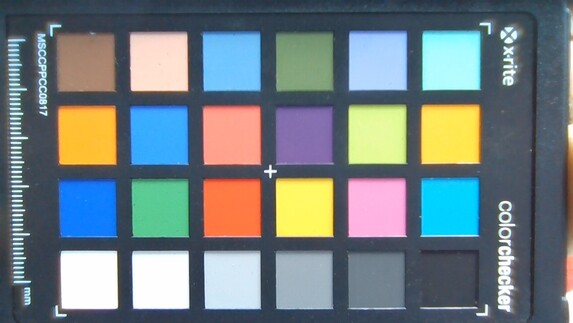
Input devices: decent laptop keyboard despite tiny case
Since the keyboard extends from the left to the right edge of the device, Huawei accommodates a keyboard with a reasonable key size despite the compact dimensions. A num pad is missing, and other function keys are also not installed. The key drop is expectedly small due to the device's thinness, but it is sufficient. Thus, a solid typing feel is achieved after a short familiarization period. The typing noise is also very low. Only the space bar is, as so often, not really quiet, but quieter than in many other notebooks.
Above the keyboard on the right is the power button with integrated fingerprint sensor. Below the space bar is the touchpad, which measures around 12 x 7 cm (~4.7 x 2.8 inches). The feel is pleasant, the control over the mouse pointer good. Left clicks are possible over the entire surface, apart from the lower right corner for right clicking.
Display: 3K resolution on only 13 inches
Huawei gives the MateBook X a 3K touch display with a resolution of 3000 x 2000 pixels despite its compact dimensions of 13 inches. This results in a high pixel density and thus a detailed picture. Subjectively, the MateBook X is a pleasing display.
The measured values also prove that it is a good panel, only surpassed by the Lenovo Yoga Slim 7i Carbon 13 ITL among the comparison devices. It scores above average in terms of contrast, but lags behind the competitors in terms of 50% gray to 80% gray response time.
The brightness of the image is just under 400 cd/m², which is more than sufficient for indoor use. Touch operation works smoothly.
| |||||||||||||||||||||||||
Brightness Distribution: 89 %
Center on Battery: 384 cd/m²
Contrast: 1608:1 (Black: 0.24 cd/m²)
ΔE ColorChecker Calman: 1.75 | ∀{0.5-29.43 Ø4.78}
ΔE Greyscale Calman: 2.33 | ∀{0.09-98 Ø5}
96% sRGB (Argyll 1.6.3 3D)
61% AdobeRGB 1998 (Argyll 1.6.3 3D)
65.9% AdobeRGB 1998 (Argyll 3D)
95.9% sRGB (Argyll 3D)
64.8% Display P3 (Argyll 3D)
Gamma: 2.55
CCT: 6584 K
| Huawei MateBook X Silver Frost (2020) JDI RWLPM130M364C, LTPS, 3000x2000, 13" | Huawei MateBook X Pro 2021 TIANMA XM, IPS, 3000x2000, 13.9" | Huawei MateBook 13 2020 i5 CMN8201 P130ZFA-BA1, IPS, 2160x1440, 13" | Lenovo Yoga Slim 7i Carbon 13 ITL N133GCA-GQ1, a-SI IPS LED, 2560x1600, 13.3" | LG Gram 14Z90N LG Philips LP140WF7-SPG1, IPS, 1920x1080, 14" | |
|---|---|---|---|---|---|
| Display | -0% | 5% | 1% | 0% | |
| Display P3 Coverage (%) | 64.8 | 64.9 0% | 67.9 5% | 65.1 0% | 65 0% |
| sRGB Coverage (%) | 95.9 | 94.4 -2% | 98.5 3% | 97.1 1% | 95.5 0% |
| AdobeRGB 1998 Coverage (%) | 65.9 | 66.3 1% | 69.6 6% | 66.6 1% | 66.1 0% |
| Response Times | -4% | -3% | 8% | -13% | |
| Response Time Grey 50% / Grey 80% * (ms) | 43 ? | 37.6 ? 13% | 41.6 ? 3% | 38.4 ? 11% | 40.4 ? 6% |
| Response Time Black / White * (ms) | 22 ? | 26.4 ? -20% | 24 ? -9% | 20.8 ? 5% | 28.8 ? -31% |
| PWM Frequency (Hz) | 62500 ? | ||||
| Screen | 3% | -72% | -14% | -22% | |
| Brightness middle (cd/m²) | 386 | 502 30% | 427 11% | 325 -16% | 316.8 -18% |
| Brightness (cd/m²) | 384 | 474 23% | 415 8% | 297 -23% | 298 -22% |
| Brightness Distribution (%) | 89 | 89 0% | 94 6% | 83 -7% | 89 0% |
| Black Level * (cd/m²) | 0.24 | 0.33 -38% | 0.41 -71% | 0.26 -8% | 0.33 -38% |
| Contrast (:1) | 1608 | 1521 -5% | 1041 -35% | 1250 -22% | 960 -40% |
| Colorchecker dE 2000 * | 1.75 | 1.35 23% | 4.4 -151% | 2.2 -26% | 1.74 1% |
| Colorchecker dE 2000 max. * | 2.92 | 3.67 -26% | 11 -277% | 3.5 -20% | 5.41 -85% |
| Greyscale dE 2000 * | 2.33 | 1.7 27% | 7.5 -222% | 2.8 -20% | 2.7 -16% |
| Gamma | 2.55 86% | 2.24 98% | 2.16 102% | 2.05 107% | 2.23 99% |
| CCT | 6584 99% | 6440 101% | 6642 98% | 6452 101% | 6655 98% |
| Color Space (Percent of AdobeRGB 1998) (%) | 61 | 61.1 0% | 64 5% | 61.3 0% | 61.3 0% |
| Color Space (Percent of sRGB) (%) | 96 | 94.3 -2% | 98.6 3% | 97 1% | 95.4 -1% |
| Colorchecker dE 2000 calibrated * | 1.2 | 1.1 | 0.6 | 1.37 | |
| Total Average (Program / Settings) | -0% /
2% | -23% /
-48% | -2% /
-8% | -12% /
-16% |
* ... smaller is better
Display Response Times
| ↔ Response Time Black to White | ||
|---|---|---|
| 22 ms ... rise ↗ and fall ↘ combined | ↗ 9 ms rise | |
| ↘ 13 ms fall | ||
| The screen shows good response rates in our tests, but may be too slow for competitive gamers. In comparison, all tested devices range from 0.1 (minimum) to 240 (maximum) ms. » 47 % of all devices are better. This means that the measured response time is similar to the average of all tested devices (20.2 ms). | ||
| ↔ Response Time 50% Grey to 80% Grey | ||
| 43 ms ... rise ↗ and fall ↘ combined | ↗ 20 ms rise | |
| ↘ 23 ms fall | ||
| The screen shows slow response rates in our tests and will be unsatisfactory for gamers. In comparison, all tested devices range from 0.165 (minimum) to 636 (maximum) ms. » 70 % of all devices are better. This means that the measured response time is worse than the average of all tested devices (31.6 ms). | ||
Screen Flickering / PWM (Pulse-Width Modulation)
| Screen flickering / PWM not detected | |||
In comparison: 53 % of all tested devices do not use PWM to dim the display. If PWM was detected, an average of 8108 (minimum: 5 - maximum: 343500) Hz was measured. | |||
The display's calibration is okay ex-factory, but still leaves room for improvement. The panel covers the sRGB color space almost completely, which is sufficient for most users. The MateBook X lacks performance for professional users anyway.
The viewing angle stability of the LTPS panel is exemplary. However, outdoor use reveals that the great-looking glossy display indoors and the passable brightness take their toll: Especially in sunny surroundings, users or the sky reflect quite strongly. However, the MateBook X can also be used outdoors in shady places
Performance: Silent operation is at the expense of Intel performance
Even though the Huawei MateBook X is not a bargain with an MSRP of around 1,500 Euros (~$1833), the performance is reasonable. Huawei has subordinated everything to a low weight and silent operation. The laptop is equipped with the Intel Core i5-10210U with the onboard graphics Intel UHD Graphics 620. Both are cooled passively. Huawei also installs 16 GB LPDDR3 RAM and a 512 GB PCIe NVMe SSD. Alternative versions with a different CPU or more memory are not available.
Processor
In order to be able to realize the fanless operation, the Intel Core i5-10210U CPU of the tenth generation is appropriately tuned. As expected, the performance here is not enough to keep up with the more potent and actively cooled competition.
Under load, the MateBook X briefly reaches the maximum of 4.2 GHz, but then quickly reduces the performance gradually from around 1.5 GHz to settle at only around 900 MHz over time. It at least maintains this admittedly low level without further performance drops. Thus, the CPU temperature stays permanently below 70 °C (158 °F). The processor consumes up to 30 watts TDP (PL2) at peak performance and a minimum of 7 watts (PL1).
The MateBook X clearly lags behind in the usual CPU benchmarks. Due to the passive cooling and the thus not exhausted potential, it also remains clearly behind the average of the Intel Core i5-10210U CPU. The performance level on battery is around 60% of the mains operation.
Cinebench R20: CPU (Single Core) | CPU (Multi Core)
Cinebench R15: CPU Single 64Bit | CPU Multi 64Bit
Blender: v2.79 BMW27 CPU
7-Zip 18.03: 7z b 4 -mmt1 | 7z b 4
Geekbench 5.5: Single-Core | Multi-Core
HWBOT x265 Benchmark v2.2: 4k Preset
LibreOffice : 20 Documents To PDF
R Benchmark 2.5: Overall mean
| Cinebench R23 / Single Core | |
| Average of class Subnotebook (358 - 2165, n=75, last 2 years) | |
| Lenovo Yoga Slim 7i Carbon 13 ITL | |
| Huawei MateBook X Pro 2021 | |
| Average Intel Core i5-10210U (797 - 1063, n=3) | |
| Huawei MateBook X Silver Frost (2020) | |
| Cinebench R23 / Multi Core | |
| Average of class Subnotebook (1555 - 21812, n=74, last 2 years) | |
| Huawei MateBook X Pro 2021 | |
| Lenovo Yoga Slim 7i Carbon 13 ITL | |
| Average Intel Core i5-10210U (1794 - 4376, n=3) | |
| Huawei MateBook X Silver Frost (2020) | |
| Cinebench R20 / CPU (Single Core) | |
| Average of class Subnotebook (128 - 826, n=69, last 2 years) | |
| Lenovo Yoga Slim 7i Carbon 13 ITL | |
| Huawei MateBook X Pro 2021 | |
| Huawei MateBook 13 2020 i5 | |
| Average Intel Core i5-10210U (322 - 428, n=30) | |
| LG Gram 14Z90N | |
| Huawei MateBook X Silver Frost (2020) | |
| Cinebench R20 / CPU (Multi Core) | |
| Average of class Subnotebook (579 - 8541, n=69, last 2 years) | |
| Lenovo Yoga Slim 7i Carbon 13 ITL | |
| Huawei MateBook X Pro 2021 | |
| Huawei MateBook 13 2020 i5 | |
| Average Intel Core i5-10210U (722 - 1820, n=30) | |
| LG Gram 14Z90N | |
| Huawei MateBook X Silver Frost (2020) | |
| Cinebench R15 / CPU Single 64Bit | |
| Average of class Subnotebook (72.4 - 322, n=69, last 2 years) | |
| Lenovo Yoga Slim 7i Carbon 13 ITL | |
| Huawei MateBook X Pro 2021 | |
| Huawei MateBook 13 2020 i5 | |
| LG Gram 14Z90N | |
| Average Intel Core i5-10210U (134 - 174, n=35) | |
| Huawei MateBook X Silver Frost (2020) | |
| Cinebench R15 / CPU Multi 64Bit | |
| Average of class Subnotebook (327 - 3345, n=69, last 2 years) | |
| Lenovo Yoga Slim 7i Carbon 13 ITL | |
| Huawei MateBook 13 2020 i5 | |
| Huawei MateBook X Pro 2021 | |
| Average Intel Core i5-10210U (320 - 790, n=35) | |
| LG Gram 14Z90N | |
| Huawei MateBook X Silver Frost (2020) | |
| Blender / v2.79 BMW27 CPU | |
| Huawei MateBook X Silver Frost (2020) | |
| LG Gram 14Z90N | |
| Average Intel Core i5-10210U (585 - 1339, n=24) | |
| Huawei MateBook 13 2020 i5 | |
| Huawei MateBook X Pro 2021 | |
| Lenovo Yoga Slim 7i Carbon 13 ITL | |
| Average of class Subnotebook (159 - 2271, n=72, last 2 years) | |
| 7-Zip 18.03 / 7z b 4 -mmt1 | |
| Average of class Subnotebook (2643 - 6442, n=71, last 2 years) | |
| Lenovo Yoga Slim 7i Carbon 13 ITL | |
| Huawei MateBook X Pro 2021 | |
| Huawei MateBook 13 2020 i5 | |
| Average Intel Core i5-10210U (3504 - 4467, n=24) | |
| LG Gram 14Z90N | |
| Huawei MateBook X Silver Frost (2020) | |
| 7-Zip 18.03 / 7z b 4 | |
| Average of class Subnotebook (11668 - 77867, n=69, last 2 years) | |
| Huawei MateBook X Pro 2021 | |
| Lenovo Yoga Slim 7i Carbon 13 ITL | |
| Average Intel Core i5-10210U (10920 - 21679, n=24) | |
| Huawei MateBook 13 2020 i5 | |
| LG Gram 14Z90N | |
| Huawei MateBook X Silver Frost (2020) | |
| Geekbench 5.5 / Single-Core | |
| Average of class Subnotebook (726 - 2350, n=64, last 2 years) | |
| Lenovo Yoga Slim 7i Carbon 13 ITL | |
| Huawei MateBook X Pro 2021 | |
| Huawei MateBook 13 2020 i5 | |
| Huawei MateBook X Silver Frost (2020) | |
| Average Intel Core i5-10210U (949 - 1133, n=27) | |
| LG Gram 14Z90N | |
| Geekbench 5.5 / Multi-Core | |
| Average of class Subnotebook (2557 - 17218, n=64, last 2 years) | |
| Lenovo Yoga Slim 7i Carbon 13 ITL | |
| Huawei MateBook X Pro 2021 | |
| Huawei MateBook 13 2020 i5 | |
| Average Intel Core i5-10210U (2079 - 4256, n=27) | |
| Huawei MateBook X Silver Frost (2020) | |
| LG Gram 14Z90N | |
| HWBOT x265 Benchmark v2.2 / 4k Preset | |
| Average of class Subnotebook (0.97 - 25.1, n=69, last 2 years) | |
| Lenovo Yoga Slim 7i Carbon 13 ITL | |
| Huawei MateBook X Pro 2021 | |
| Huawei MateBook 13 2020 i5 | |
| Average Intel Core i5-10210U (2.36 - 6.28, n=24) | |
| LG Gram 14Z90N | |
| Huawei MateBook X Silver Frost (2020) | |
| LibreOffice / 20 Documents To PDF | |
| Huawei MateBook X Silver Frost (2020) | |
| LG Gram 14Z90N | |
| Average Intel Core i5-10210U (49.6 - 80.3, n=18) | |
| Huawei MateBook 13 2020 i5 | |
| Average of class Subnotebook (38.5 - 220, n=68, last 2 years) | |
| Lenovo Yoga Slim 7i Carbon 13 ITL | |
| Huawei MateBook X Pro 2021 | |
| R Benchmark 2.5 / Overall mean | |
| Huawei MateBook X Silver Frost (2020) | |
| LG Gram 14Z90N | |
| Average Intel Core i5-10210U (0.658 - 0.901, n=24) | |
| Huawei MateBook 13 2020 i5 | |
| Huawei MateBook X Pro 2021 | |
| Lenovo Yoga Slim 7i Carbon 13 ITL | |
| Average of class Subnotebook (0.403 - 1.456, n=70, last 2 years) | |
* ... smaller is better
System performance
As with the CPU performance measurements, the system benchmarks also show the performance of Huawei's MateBook X, which is designed for silent operation. Here, too, the lightweight is behind the comparison models, but mostly manages to be about average for the class.
| PCMark 8 Home Score Accelerated v2 | 3324 points | |
| PCMark 8 Creative Score Accelerated v2 | 4951 points | |
| PCMark 8 Work Score Accelerated v2 | 4289 points | |
| PCMark 10 Score | 3448 points | |
Help | ||
DPC latencies
| DPC Latencies / LatencyMon - interrupt to process latency (max), Web, Youtube, Prime95 | |
| LG Gram 14Z90N | |
| Huawei MateBook X Pro 2021 | |
| Huawei MateBook 13 2020 i5 | |
| Lenovo Yoga Slim 7i Carbon 13 ITL | |
| Huawei MateBook X Silver Frost (2020) | |
* ... smaller is better
Mass storage
With the Huawei MateBook X Pro 2021 the Pro-less MateBook X cannot quite keep up in terms of mass storage performance. However, the 512 GB SSD from Samsung does well in the field and can position itself above the subnotebook class.
| Huawei MateBook X Silver Frost (2020) Samsung SSD PM981a MZVLB512HBJQ | Huawei MateBook X Pro 2021 Samsung PM981a MZVLB1T0HBLR | Huawei MateBook 13 2020 i5 WDC PC SN730 SDBPNTY-512G | Lenovo Yoga Slim 7i Carbon 13 ITL Samsung SSD PM981a MZVLB512HBJQ | LG Gram 14Z90N Samsung SSD PM981 MZVLB256HAHQ | Average Samsung SSD PM981a MZVLB512HBJQ | Average of class Subnotebook | |
|---|---|---|---|---|---|---|---|
| CrystalDiskMark 5.2 / 6 | 23% | -6% | 1% | 1% | 5% | 32% | |
| Write 4K (MB/s) | 164.5 | 197.5 20% | 190.5 16% | 139.5 -15% | 183.6 12% | 140.8 ? -14% | 148.5 ? -10% |
| Read 4K (MB/s) | 50.7 | 52.9 4% | 53.7 6% | 36.38 -28% | 48.51 -4% | 48.6 ? -4% | 63.6 ? 25% |
| Write Seq (MB/s) | 1813 | 2174 20% | 1436 -21% | 1977 9% | 1520 -16% | 2106 ? 16% | 2521 ? 39% |
| Read Seq (MB/s) | 1722 | 2156 25% | 1356 -21% | 2207 28% | 1914 11% | 2099 ? 22% | 3134 ? 82% |
| Write 4K Q32T1 (MB/s) | 368.5 | 632 72% | 382.5 4% | 510 38% | 529 44% | 451 ? 22% | 427 ? 16% |
| Read 4K Q32T1 (MB/s) | 492.2 | 694 41% | 502 2% | 387.8 -21% | 560 14% | 482 ? -2% | 493 ? 0% |
| Write Seq Q32T1 (MB/s) | 2986 | 3017 1% | 2114 -29% | 2986 0% | 1540 -48% | 2903 ? -3% | 4405 ? 48% |
| Read Seq Q32T1 (MB/s) | 3548 | 3561 0% | 3410 -4% | 3540 0% | 3408 -4% | 3511 ? -1% | 5567 ? 57% |
| AS SSD | 6% | 5% | 2% | -32% | -11% | 3% | |
| Seq Read (MB/s) | 2800 | 2794 0% | 2912 4% | 2861 2% | 1744 -38% | 2412 ? -14% | 4311 ? 54% |
| Seq Write (MB/s) | 2358 | 2385 1% | 2190 -7% | 1321 -44% | 1450 -39% | 1983 ? -16% | 2879 ? 22% |
| 4K Read (MB/s) | 59.2 | 60.7 3% | 49.52 -16% | 52.5 -11% | 57.4 -3% | 53.1 ? -10% | 58.9 ? -1% |
| 4K Write (MB/s) | 142.6 | 180.8 27% | 167.1 17% | 196.7 38% | 140.9 -1% | 131.1 ? -8% | 168.9 ? 18% |
| 4K-64 Read (MB/s) | 1260 | 1768 40% | 1447 15% | 1153 -8% | 907 -28% | 1201 ? -5% | 877 ? -30% |
| 4K-64 Write (MB/s) | 1408 | 1800 28% | 1513 7% | 1807 28% | 1372 -3% | 1726 ? 23% | 1752 ? 24% |
| Access Time Read * (ms) | 0.048 | 0.037 23% | 0.05 -4% | 0.064 -33% | 0.059 -23% | 0.05525 ? -15% | 0.0591 ? -23% |
| Access Time Write * (ms) | 0.026 | 0.073 -181% | 0.023 12% | 0.018 31% | 0.081 -212% | 0.05394 ? -107% | 0.06163 ? -137% |
| Score Read (Points) | 1599 | 2108 32% | 1787 12% | 1491 -7% | 1138 -29% | 1495 ? -7% | 1367 ? -15% |
| Score Write (Points) | 1786 | 2219 24% | 1899 6% | 2136 20% | 1658 -7% | 2055 ? 15% | 2207 ? 24% |
| Score Total (Points) | 4192 | 5392 29% | 4569 9% | 4322 3% | 3380 -19% | 4303 ? 3% | 4215 ? 1% |
| Copy ISO MB/s (MB/s) | 1746 | 2065 18% | 2290 31% | 1520 -13% | 1894 ? 8% | 2558 ? 47% | |
| Copy Program MB/s (MB/s) | 725 | 734 1% | 555 -23% | 539 -26% | 539 ? -26% | 796 ? 10% | |
| Copy Game MB/s (MB/s) | 1203 | 1629 35% | 1300 8% | 1070 -11% | 1193 ? -1% | 1736 ? 44% | |
| Total Average (Program / Settings) | 15% /
12% | -1% /
1% | 2% /
2% | -16% /
-20% | -3% /
-6% | 18% /
13% |
* ... smaller is better
Continuous reading: DiskSpd Read Loop, Queue Depth 8
Graphics card
The trend in the CPU's performance tuning also affects the onboard graphics. Here, too, Huawei aims for the coolest possible operation. In the final result, the graphics performance does not quite reach the average of the Intel UHD Graphics 620 average. The gap to comparison models with Intel Iris Plus Graphics G7 is gigantic. However, these are not the standards that Huawei wants to measure the MateBook X against.
| 3DMark 11 Performance | 1272 points | |
| 3DMark Cloud Gate Standard Score | 6919 points | |
| 3DMark Fire Strike Score | 920 points | |
| 3DMark Time Spy Score | 389 points | |
Help | ||
Gaming performance
It should be clear to everyone that the passively cooled and ultra-thin Huawei MateBook X is not a gaming machine. This is also very clear in the test: Witcher 3 is not playable even on the lowest graphics settings. Dota 2 Reborn, on the other hand, runs surprisingly smoothly on the lowest settings. The adequate performance is sufficient for a few older and less demanding titles. However, more is not possible with the best will in the world.
| low | med. | high | ultra | |
|---|---|---|---|---|
| The Witcher 3 (2015) | 13.2 | 8.2 | ||
| Dota 2 Reborn (2015) | 51.5 | 25.1 | 12.8 | 11.9 |
| X-Plane 11.11 (2018) | 14.9 | 9.77 | 9.08 |
Emissions & Energy: Huawei MateBook X proves to be economical in the test
Noise emissions
This section can be kept very compact. Since Huawei runs the device without a fan, this point is the star hour for the MateBook X (2020). The operation is completely silent. There are also no beeps or other noises, apart from the usual typing and clicking noises. Thus, this subnotebook is the ideal companion for all libraries in the world.
Temperature
Although there is no active cooling via a fan, the device is pleasantly cool in operation. It stays at room temperature in idle mode. Under load, it warms up to a maximum of 40 °C (104 °F).
(±) The maximum temperature on the upper side is 40.7 °C / 105 F, compared to the average of 35.9 °C / 97 F, ranging from 21.4 to 59 °C for the class Subnotebook.
(±) The bottom heats up to a maximum of 40.4 °C / 105 F, compared to the average of 39.3 °C / 103 F
(+) In idle usage, the average temperature for the upper side is 23.8 °C / 75 F, compared to the device average of 30.8 °C / 87 F.
(+) The palmrests and touchpad are cooler than skin temperature with a maximum of 30 °C / 86 F and are therefore cool to the touch.
(±) The average temperature of the palmrest area of similar devices was 28.2 °C / 82.8 F (-1.8 °C / -3.2 F).
Speaker
A thin case means little space for the four speakers. Nevertheless, they sound relatively balanced, but lack bass. Overall, the Huawei MateBook X is above the class average.
Huawei MateBook X Silver Frost (2020) audio analysis
(+) | speakers can play relatively loud (82.5 dB)
Bass 100 - 315 Hz
(-) | nearly no bass - on average 20.2% lower than median
(±) | linearity of bass is average (12.9% delta to prev. frequency)
Mids 400 - 2000 Hz
(+) | balanced mids - only 2% away from median
(+) | mids are linear (5.4% delta to prev. frequency)
Highs 2 - 16 kHz
(±) | higher highs - on average 5.4% higher than median
(+) | highs are linear (3.6% delta to prev. frequency)
Overall 100 - 16.000 Hz
(+) | overall sound is linear (14.1% difference to median)
Compared to same class
» 26% of all tested devices in this class were better, 6% similar, 68% worse
» The best had a delta of 5%, average was 18%, worst was 53%
Compared to all devices tested
» 16% of all tested devices were better, 4% similar, 80% worse
» The best had a delta of 4%, average was 24%, worst was 134%
Apple MacBook 12 (Early 2016) 1.1 GHz audio analysis
(+) | speakers can play relatively loud (83.6 dB)
Bass 100 - 315 Hz
(±) | reduced bass - on average 11.3% lower than median
(±) | linearity of bass is average (14.2% delta to prev. frequency)
Mids 400 - 2000 Hz
(+) | balanced mids - only 2.4% away from median
(+) | mids are linear (5.5% delta to prev. frequency)
Highs 2 - 16 kHz
(+) | balanced highs - only 2% away from median
(+) | highs are linear (4.5% delta to prev. frequency)
Overall 100 - 16.000 Hz
(+) | overall sound is linear (10.2% difference to median)
Compared to same class
» 7% of all tested devices in this class were better, 2% similar, 91% worse
» The best had a delta of 5%, average was 18%, worst was 53%
Compared to all devices tested
» 4% of all tested devices were better, 1% similar, 94% worse
» The best had a delta of 4%, average was 24%, worst was 134%
Energy absorption
The maximum power consumption of Huawei's MateBook X is a good 30 watts in the test. Thus, the 65-watt power supply is more than adequately sized and provides enough room for improvement.
| Off / Standby | |
| Idle | |
| Load |
|
Key:
min: | |
Battery life
The MateBook X achieves good battery runtimes in the test. It cannot quite keep up with most of the comparison models, but they also have a larger battery due to their space. The Huawei MateBook 13 2020 i5 with about 42 Wh beats it easily, and is even on par with the Lenovo Yoga Slim 7i Carbon 13 ITL with 50 Wh.
Pros
Cons
Verdict: Silent companion convinces in the test
Those looking for a particularly light and compact notebook will undoubtedly find what they are looking for with Huawei's MateBook X. Weighing just one kilogram (~2.2 lb), the 13-incher is extremely light and thus the ideal companion for on the go.
The second big advantage of the device is its silent operation because it does not have a fan. It is not surprising that this is at the expense of the performance.
The Huawei MateBook X proved itself for everyday tasks, such as web browsing, a few office applications, and streaming videos in the test. However, it quickly loses its edge when it comes to more demanding tasks. Users who can do without silent operation and want more performance and even longer battery runtimes are better off with LG's current Gram models. A review of the 14-inch model will follow soon.
Price and availability
The Huawei MateBook X Silver Frost (2020) with the model number EUL-W19D (Intel Core i5-10210U processor, 16 GB RAM, 512 GB SSD) is available at the time of our test for a price of 1,142 Euros (~$1395) at Cyberport and for 1,249 Euro (~$1526) at Notebooksbilliger.de.
Huawei MateBook X Silver Frost (2020)
- 05/18/2021 v7 (old)
Marcus Schwarten




